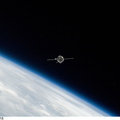
WIKIARCHIVES.SPACE
The Human Spaceflight Archive

Information
- Taken in
- Space
- Author
- NASA
- Description
- A circle in thin ice in Lake Baikal, Russia is featured in this image photographed by an Expedition 19 crewmember on the International Space Station. Late in April 2009, astronauts aboard the station observed a strange circular area of thinned ice (dark in color, with a diameter of about 4.4 kilometers) in the southern end of Lake Baikal in southern Siberia. Lake Baikal is unique in many regards. It is the largest (by volume) and deepest (1,637 meters at the deepest point) fresh water lake on Earth and, as a World Heritage Site, is considered one of Russia's environmental jewels. The lake's long, thin and deep profile results from its location in the Baikal Rift valley in Siberia. According to scientists, it is also one of the world's oldest lakes (25-30 million years old); it contains up to 7 kilometers of sediment deposited on the bottom, and is home to an amazing array of plants and animals, many being found only in Lake Baikal. The lake's biodiversity includes fresh water seals and several species of fish that are not found elsewhere on Earth. Siberia is remote and cold; ice cover can persist into June. This detailed image shows a circle of thin ice, which is the focal point for ice break up in the very southern end of the lake. While the origin of the circles is unknown, the peculiar pattern suggests convection in the lake's water column. Ice cover changes rapidly at this time of year. Within a day, the ice can melt almost completely, and then freeze again overnight. Throughout April, the circles are persistent -- they appear when ice cover forms, and then disappear as ice melts. The pattern and appearance suggests that the ice is quite thin.
- Created on
- Thursday 23 April 2009
- Albums
- ISS (WIP) / EXPEDITIONS / EXPEDITION 19
- Source link
- https://www.flickr.com/photos/nasa2explore/albums/72157627450576184
- Visits
- 17
- Rating score
- no rate
- Rate this photo
- License
- CC BY-NC-ND
- Modified by WikiArchives
- No (original)
- Downloads
- 0
EXIF Metadata
NIKON CORPORATION NIKON D3
- Make
- NIKON CORPORATION
- Model
- NIKON D3
- DateTimeOriginal
- 2009:04:23 23:51:43
- ApertureFNumber
- f/5.6
Powered by Piwigo































































































































































































































































































































